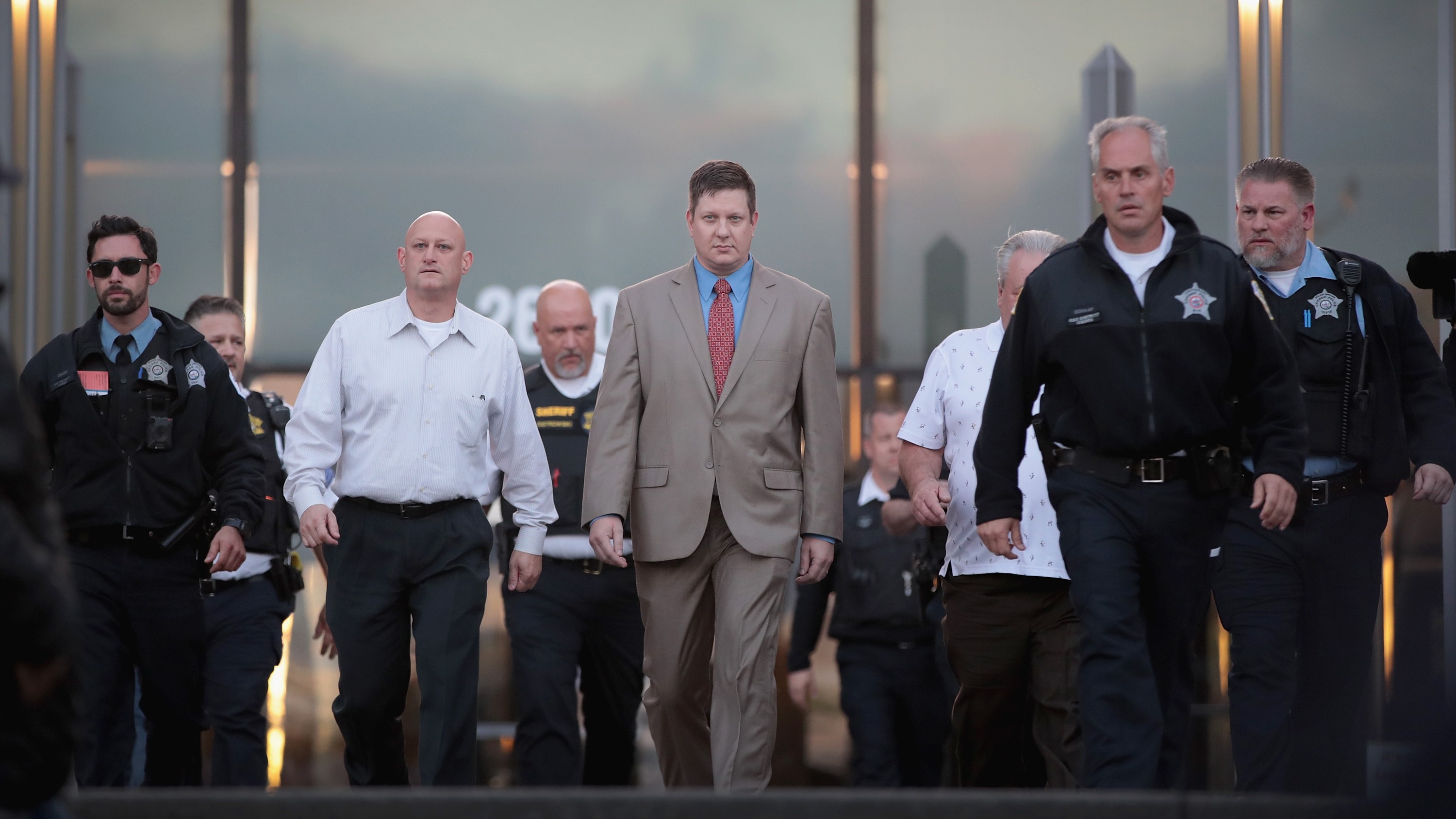William Sonvico / EyeEm / Getty Images
Dressed in a short-sleeve, light blue shirt and cream khakis, Guillermo Ravelo stepped up to the podium in a Miami federal courtroom last week and did something rare: He admitted to being a dirty cop.His voice quivering, the 37-year-old said he made false arrests and pinned unsolved crimes on innocent individuals while on patrol in nearby Biscayne Park, a tiny village of about 3,200 people.“I realize what I did was completely unacceptable,” Ravelo told US District Judge Cecilia Altonaga. “I let down my family, my friends, the department, the people I serve, and most of all my two boys.”

The broad-shouldered Ravelo, who pleaded guilty in July to deprivation of rights and conspiracy against rights, broke down as he slumped back into his seat. His wife and cousins, sitting in the second row behind the defense table, shed tears of their own. Altonaga soon sentenced him to 27 months in prison.Ravelo’s mea culpa capped off a week in which two other former Biscayne Park cops, Charlie Dayoub and Raul Fernandez, were also sent to prison for their roles in an egregious police misconduct case that reached the tippy-top of the local police department. Both men pleaded guilty to deprivation of rights for falsely arresting a 16-year-old boy for a series of unsolved burglaries in 2013. Their attorneys declined comment.The three officers, who agreed to cooperate with the feds as part of their plea deals, were under marching orders from Raimundo Atesiano, a bald 52-year-old with a cartoonish, bushy mustache who served as Biscayne Park’s police chief. Atesiano pleaded guilty last month to conspiracy to deprive three suspects of their civil rights and was awaiting sentencing. He faced up to ten years in prison.Among other things, Atesiano instructed cops to falsely arrest individuals for burglaries in the village, and, in at least one case, provided Ravelo with specific falsehoods to put in a report used as the basis to make an arrest, according to court documents and federal prosecutor Harry Wallace. While Wallace did not go after Atesiano and the three others for targeting people of color, a 2014 Biscayne Park internal affairs report suggested the department’s top brass pushed officers to zero in on people who were black.Atesiano and his boys in blue were just the latest crew of corrupt cops to get put on blast in America. Early this year, an elite street unit of the Baltimore Police was exposed for carrying toy guns to plant on suspects and targeting drug dealers so as to rob and resell their weight. Several task force members pleaded guilty and testified against two other former colleagues who were found guilty at trial.What made the Biscayne Park case particularly galling is that the cops seemed to settle on a concerted, top-down strategy of selecting random people of color to pin unsolved crimes on."Usually, when police are trying to manipulate numbers, they will suppress the number of crimes actually committed by losing reports or not including it in the numbers reported to the city council," Kyle McLean, a criminologist and expert on policing at Florida State University, told me. “But officers artificially lowering the crime rate by picking people at random and charging them with unsolved crimes? That's unheard of."Encompassing less than a square-mile and geographically shaped like a trapezoid, Biscayne Park is a predominantly single-family area with a police force of about a dozen officers, including the command staff. The village is nearly 70 percent white and a 1930s log cabin served as the official town hall and police department until recently.According to Atesiano’s indictment, he manufactured an artificial clearance rate of 100 percent for burglaries because he was motivated by a desire to "gain favor” from Biscayne Park’s elected officials and residents. He was accused of directly participating in the framing of three individuals, including the 16-year-old boy, for burglaries they did not commit between 2013 and 2014. All of them were black.“This particular case and its specifics are fairly unique, but what is not unique is the pressure many police departments are under to have good numbers in terms of crime rates and clearance rates,” Eli Silverman, a professor emeritus at John Jay College of Criminal Justice who has trained police agencies, told me. “Since the 1990s, when statistics nationwide began showing that crime was decreasing, the pressure has only intensified and there are many ways police departments may respond inappropriately to this pressure.”Minutes of a Biscayne Park village commission meeting in July 2013 appeared to confirm Atesiano’s illegal arrest tactics fooled his bosses. "The entire staff is doing a great job," then-Vice Mayor Bob Anderson said. "The stats show it. Great clearance rate. We have the reputation that bad guys will get caught."Except the alleged bad guys were innocent. Four officers confided in an outside investigator that the command staff directed them to make bogus arrests to juke the village’s crime stats, and at least one cop specifically said they were instructed to target black people, according to the 2014 internal affairs report. The investigation was initiated by former Biscayne Park Village Manager Heidi Shafran after active-duty cops upset with what was going on got in touch with her; Shafran told the Miami Herald letters from the officers said they "were directed to pick up people of color and blame the crimes on them.”The findings were never discussed at village commission meetings, but Atesiano resigned in 2014 under the cloud of the internal probe. As part of his guilty plea, the ex-chief admitted to instructing Dayoub and Fernandez to falsely arrest an individual identified only as “CD” for two unsolved burglaries on or after January 23, 2013. A man named Clarens Desrouleaux has since claimed he was the one wrongly fingered for the two burglaries in a federal lawsuit filed against Biscayne Park, Atesiano, Dayoub and Ravelo. Desrouleaux, a black Haitian who was a legal US resident at the time of his arrest, said he fit the racial profile of people targeted for false arrests and that Dayoub and Ravelo coerced him into falsely confessing to the burglaries.Dayoub and Ravelo testified in depositions that Desrouleaux snitched on himself, and the fear of a 30-year prison sentence convinced him to plead guilty and accept five years in prison, the lawsuit claimed. When Desrouleaux was released in 2017, he was deported back to Haiti and has not been able to return to the US—even though his convictions and sentence were vacated in August following the indictment of his Biscayne Park captors, as the Herald reported.In another case that was part of Ravelo’s guilty plea, Atesiano ordered him to frame a black man identified as “EB” who was in their custody on an unrelated charge. In court documents, Ravelo said Atesiano instructed him to falsely arrest and charge EB with five unsolved vehicle burglaries. “Chief RA orally dictated a false narrative for [Ravelo] to include in the arrest affidavits charging EB,” the factual proffer attached to Ravelo's plea deal states.In each affidavit, Ravelo falsely wrote that EB, while being transported in a patrol car, took him to the addresses where the crimes took place and identified the vehicles that were burglarized.Jackie Azis, staff attorney for the Florida chapter of the American Civil Liberties Union, argued the modern criminal justice system continues to makes it easy for corrupt law-enforcement officials to set people up. “Unfortunately, a lot of times these actions go unnoticed,” she said. “Because the way the criminal justice works, people claiming innocence still plead guilty and it may never come out that they were framed in this way.”Still, even Azis said she was taken aback by the actions of the Biscayne Park cops. “What happened here is so horrific, it strikes at the core of injustice,” she told me.Silverman, who co-authored a book on crime statistics manipulation by the New York Police Department, which helped pioneer metrics-based policing with the infamous COMPSTAT system, agreed. “The fact this police department singled out a particular group makes it even more odious, “he said, adding that the only way to discourage police departments from framing people to juice numbers was for politicians to ease up on demands to bring crime down.“They shouldn’t be aiming to have perfect records,” Azis told me. “They should be aiming for justice and achieving it in lawful ways.”Sign up for our newsletter to get the best of VICE delivered to your inbox daily.Follow Francisco Alvarado on Twitter.
Advertisement

The broad-shouldered Ravelo, who pleaded guilty in July to deprivation of rights and conspiracy against rights, broke down as he slumped back into his seat. His wife and cousins, sitting in the second row behind the defense table, shed tears of their own. Altonaga soon sentenced him to 27 months in prison.Ravelo’s mea culpa capped off a week in which two other former Biscayne Park cops, Charlie Dayoub and Raul Fernandez, were also sent to prison for their roles in an egregious police misconduct case that reached the tippy-top of the local police department. Both men pleaded guilty to deprivation of rights for falsely arresting a 16-year-old boy for a series of unsolved burglaries in 2013. Their attorneys declined comment.The three officers, who agreed to cooperate with the feds as part of their plea deals, were under marching orders from Raimundo Atesiano, a bald 52-year-old with a cartoonish, bushy mustache who served as Biscayne Park’s police chief. Atesiano pleaded guilty last month to conspiracy to deprive three suspects of their civil rights and was awaiting sentencing. He faced up to ten years in prison.Among other things, Atesiano instructed cops to falsely arrest individuals for burglaries in the village, and, in at least one case, provided Ravelo with specific falsehoods to put in a report used as the basis to make an arrest, according to court documents and federal prosecutor Harry Wallace. While Wallace did not go after Atesiano and the three others for targeting people of color, a 2014 Biscayne Park internal affairs report suggested the department’s top brass pushed officers to zero in on people who were black.
Advertisement
Advertisement
Advertisement
Advertisement
